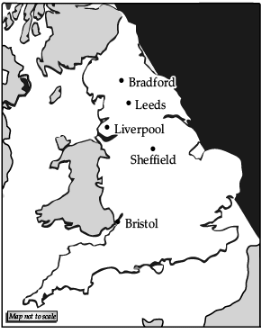History: CBSE Sample Question Paper (2020-21) - 3 - Humanities/Arts PDF Download
Class - XI
History
TIME: 3 Hrs.
M.M: 80
General Instructions :
Read the below instructions very carefully and follow them strictly.
(i) Answer all the questions. Some questions have an internal choice. Marks are indicated against each question. This question paper comprises six sections.
(ii) Section A: Question numbers 1 to 16 are objective type questions carrying 1 mark and should be answered in one word or one sentence each (Attempt any 15).
(iii) Section B: Question numbers 17 to 19 are Case-Based/Source-Based having Multiple Choice questions carrying 3 marks each. Each question has 4 sub-parts. Attempt any three sub-parts from each question.
(iv) Section C: Answer to questions 20 to 23 carrying 3 marks each should not exceed 100 words each.
(v) Section D: Answer to questions 24 to 26 carrying 8 marks each should not exceed 350 words each.
(vi) Section E: Question number 27 to 29 are Source-based questions carrying 5 marks each.
(vii) Section F: Question number 30 is a Map question that includes the identification and location of significant test items. Attach the map with the answer book.
Section-A [15 marks]
Attempt any 15 questions. [1 mark each]
Q.1. Fill up in the blanks A Muslim writer, ………….. was regarded as a man of wisdom in the Italian world.
Ans. Ibn Sina
OR
The first Railway line connected the cities of ………… and ……………
Ans: Stockholm and Darlington
Q.2. State whether true or false:
Jizya was a tax imposed on the Muslims.
Ans: false
Q.3. Identify the Picture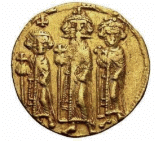 Ans: Byzantine Gold Solidus
Ans: Byzantine Gold Solidus
Q.4. Given below are two statements one labelled as Assertion (A) & the other is Reason (R).
Assertion (A): From the eleventh century, the personal bonds that had been the basis of feudalism were weakening.
Reason (R): Economic translations were becoming more and more money based.
Options~
(a) Both (A) and (R) are correct, but (R) is correct explanation of (A)
(b) Both (A) and (R) are correct but (R) is not the correct explanation of A
(c) (A) is correct but (R) is not
(d) (R) is correct but (A) is not correct.
Ans: a
Q.5. From the fourteenth to the seventeenth century, towns were growing in many countries of Europe because:
(a) A distinct “Urban Culture” was developed.
(b) Townspeople began to think as more civilised.
(c) Towns became centres of art and learning.
(d) All of these
(A) only a
(B) a and c
(C) only d
(D) only c
Ans: c
Q.6. Read the following information and identify the name of the writer of the early fifth century;
The aristocracy based in the city of Rome drew annual incomes of up-to 4000 Ibs of gold from their estates, not counting the produce they consumed directly!
Ans: Olympiodorus
Q.7. Fill in the blanks:
The invention of ………………… took the entire process of industrialization to a second stage.
Ans: Railways
Q.8. In which city of Mesopotamia the Warka Head has been found?
(a) Ur
(b) Mari
(c) Babylonia
(d) Uruk
Ans: d
Q.9. What was the name of the measurement unit made by Watt?
Ans: Horsepower.
Q.10. Which of the following is not true about Mesopotamian Temples;
(a) The God was the focus of worship
(b) Temples had their outer walls going in and out at regular intervals.
(c) Enormous and Gilgamesh were two gods of Mesopotamia.
(d) The earlier known temple was a small shrine made of unbaked bricks
(A) a and c
(B) only c
(C) only d
(D) c and d
Ans: b
Q.11. Identify the name of the leader who spoke these words
“Freedom is more precious than order.”
Ans: Ueki Emori – the leader of the popular rights movement.
Q.12. Fill in the blanks:
By the early fifteenth century, the teacher who taught grammar, rhetoric, poetry, history and moral philosophy were called…..
Ans: Humanists.
Q.13. Fill in the blanks:
After the decline of the Manchu Empire, a ____ was established in 1911 in China.
Ans: Republic
Q.14. Japan was considered rich. Identify the appropriate Reason from:
(a) Japan imported luxury goods like silk.
(b) Imports of gold and silver strained the economy and led Tokugawa to impose
restrictions on the export of precious metals.
(c) Japan took steps to develop the silk industry in Nishijin in Kyoto.
(d) All of these
Ans: d
Q.15. Look at the figure given below and name it,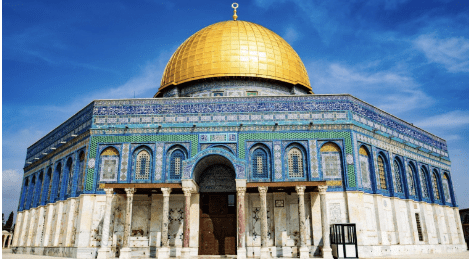 Ans: The Dome of the Rock.
Ans: The Dome of the Rock.
Q.16. State whether the following statement is True or False: The Christian society believed that the earth was the centre of the universe.
Ans: True
Section-B [9 marks]
[3 marks each]
In this part all questions are compulsory
Q.17. Study this picture of Clay Tablet used by Mesopotamians carefully and answer ANY THREE of the following questions by choosing the correct option: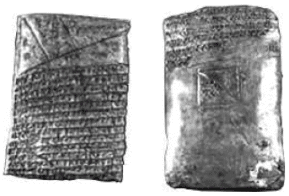
(A) Mesopotamians wrote on tablets of clays.
(i) The above statement is True.
(ii) The statement is partially True.
(iii) The above statement is False.
(iv) None of these.
Ans: i
(B) The Clay tablet depicts a picture of;
(i) A Poetry written by Mesopotamians.
(ii) A mathematical exercise with triangles and lines.
(iii) A science experiment.
(iv) A secret document with codes.
Ans: ii
(C) Mesopotamia is widely known due to;
(i) Records of Literature and Poetry
(ii) Availability of sources including clay tablets in abundance.
(iii) Availability of records in English.
(iv) All of the above.
Ans: ii
(D) The letters and signs depicted in the above pictures are known as cuneiform and the language used was Sumerians;
(i) The above statement is True.
(ii) The statement is partially True.
(iii) The above statement is False.
(iv) None of these.
Ans: i
Q.18. Study this picture carefully and answer ANY THREE of the following questions by choosing the correct option:
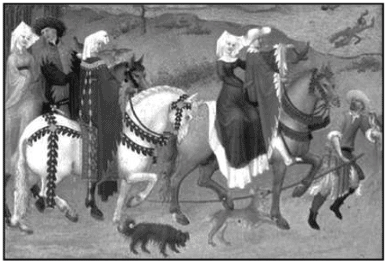
1. The above picture illustrates a scene and popularly known as:
(i) Horse Riding Party
(ii) Playing Golf Party.
(iii) Hunting Party.
(iv) British Family Party.
Ans: iii
2. The above picture is an illustration of:
(i) Fourteen Century
(ii) Fifteen Century
(iii) Sixteen Century
(iv) None of these.
Ans: ii
3. An elaborately dressed group of noblemen and noblewomen are shown carrying:
(i) Golf Sticks.
(ii) Falcons.
(iii) Arrows
(iv) None of these.
Ans: ii
4. The noblemen and noblewomen are shown accompanying:
(i) Their servants and their dogs.
(ii) The Royal family.
(iii) Soldiers.
(iv) None of these.
Ans: i
Q.19. Study the below picture of Roman Empire carefully and answer ANY THREE of the following questions by choosing the correct option:

1. The Roman Empire extended over how many continents?
(i) One
(ii) Two
(iii) Three
(iv) Four
Ans: iii
2. What constituted the heart of the empire?
(i) Sahara Desert
(ii) The Mediterranean Sea
(iii) Rhine
(iv) Agriculture
Ans: ii
3. Which of these sources is available for the reconstruction of Roman history?
(i) Poems
(ii) Texts
(iii) Stories
(iv) Rivers
Ans: ii
4. When did the Roman Empire become a Republic?
(i) 505 BCE
(ii) 905 BCE
(iii) 5 09 BCE
(iv) 100 BCE
Ans: iii
Section - C [12 marks]
[3 marks each]
In this part all questions are compulsory.
Q.20. What were the three principles of Sun Yat-Sen? Which Four great needs were identified by the Guomindang under his leadership?
Ans: Sun Yat-Sen put forward three guiding principles for Chinese revolutionary league. These were Nationalism, Democracy and Livelihood. The last one of these is also referred to as Socialism. In specific terms these principles meant the end of the Manchu Dynasty.
The Guomindang was a national party of China that was established by Sun Yat-Sen 1912 merging several other parties. This party formed the Canton Government in South China in 1902. When Chiang Kai-Shek took over the leadership he encouraged the women to cultivate four virtues of chastity, appearance, speech and work.
Q.21. What were the effects of the Crusades on Europe and Asia?
Ans:
(a) The Crusades left a lasting impact on the aspects of Christian Muslim relations.
(b) The Muslim states developed harsher attitudes towards its Christian subjects.
(c) In the areas of mixed populations (Muslim, Jews and Christians), religious conflicts intensified.
(d) There was a greater influence of Italian mercantile communities (from Pisa, Genoa and Venice) in the trade between the East and the West even after the restoration of Muslim power.
(e) In the first crusade, soldiers from France and Italy captured Antioch in Syria and also claimed Jerusalem. Their victory was marked by the slaughter of Muslims and Jews.
(f) They increased the power of the church in Europe and increased its ability to create wars and inflict violence on the common people.
Q.22. Name the first four Caliphs. Explain their role in the expression of Islamic territories.
Ans: After the death of Muhammad, a number of tribes broke away from the Islamic state. Some of them even raised their own Prophets to establish communities on the basis of Umma.
(i) The first Caliph, Abu Bakr, launched a number of campaigns to suppress the revolts.
(ii) The second Caliph, Umar, adopted the policy of expansion of the power of Umma. He and his military commanders mustered their tribal strength to conquer the Byzantine Empire in the west and Sasanian Empire in the east, both of which had huge resources. Arabs brought Iraq, Syria, Iran and Egypt under the control of Medina with three successful campaigns during 637-642.
(iii) The third Caliph, Uthman, launched further campaigns to gain control over Central Asia. Thus, a vast territory between the Nile and the Indus came under the control of the Arab-Islamic state within ten years of the death of Muhammad. These lands remain under Muslim rule to this day.
(iv) The fourth Caliph, Ali (656-61) fought two wars against the people representing the aristocracy of Mecca due to which the rifts among the Muslims deepened. Later on, Ali’s supporters and enemies formed two main sects of Islam, i.e. Shias and Sunnis. Ali established himself at Kufa. He defeated the army led by Aisha, Muhammad’s wife, in the Battle of Camel in 657. The second battle at Siffin with Muawiya ended in a truce. This divided his followers into two groups. Those who left him were known as Kharijites. Soon after, Ali was assassinated by a Kharji.
Q.23. What story of the flood mentioned in the Bible, had a similarity in Mesopotamian tradition?
Ans: According to the Bible, a great flood occurred which was meant to destroy all life on earth. However, Noah was chosen by God to ensure the continuance of life after the flood. He built a huge boat and took a pair of each known species of animals and birds and saved them from the flood. There is a strikingly similar story in Mesopotamian tradition, where the main character was called Ziusudra or Utnapishtim.
Section D [24 marks]
In this part all questions are compulsory
Q.24. What was the function of medieval monasteries?
Ans. Monasteries were Christian institutions of medieval Europe were devout Christians lead a life of isolation dedicated to the worship of God. These monasteries were located far from the areas of human habitation. The two famous monasteries were St. Benedict in Italy and Cluny in Burgundy. The functions performed by these monasteries are as follows:
(1) Preaching: Monks and nuns moved from one place to another to spread the words of Christianity among the people.
(2) Charity: Monasteries served the sick and arranged food for the hungry people. The monasteries served as inns for the travellers. They could halt at these monasteries and then continue their journey.
(3) Learning centres: Monasteries provided education to the community children and those who wanted to become monks.
(4) Cultural Enrichment:
(i) Most monks and nuns were educated and learned, so they spent their time copying books and masterpieces like the works of Cicero and Virgil.
(ii) Monks were also the chroniclers; they noted down all important events of their times.
(iii) Monasteries served as important centres of art. Monks and nuns served God as His creative artists. One brilliant example is Abbess Hildegard who developed the practice of community singing in churches.
OR
How did long term change in population levels affect the economy and society in Europe?
Ans. Europe witnessed a huge rise in its population during the medieval period. There was an estimated rise of around 30 million people from the 10th century to the 13th century. This rise in the population had several economic and social effects.
Economic Effects
(1) Establishment of towns: With the advancement of agricultural technologies, the production of food increased. Peasants, thus, felt the need of a place where they could sell their surplus and buy tools and clothes in return. Periodic fairs and small marketing centres started to spring up here and there. Surrounding these centres, other infrastructure developments took place, which, in turn, led to the growth of towns.
(2) Organisation of trading activities: Guilds or associations of traders were formed in towns to take care of the quality of goods exchanged in the markets and their prices.
(3) Trade routes: With the increased production of food, the search for fresh markets started and so several new trade routes developed. An important example is the route followed by Scandinavian merchants from the North Sea to southern lands.
Social Effects
(1) Air of relief for the serfs: Often, serfs fled from the estates and took shelter in the towns. If a lord could not track his serf within a year, then the serf would become a free man.
(2) Paid work: In towns, the labour was always offered in exchange for a payment. Tax instead of service was paid by the residents of the town to the landowner. This allowed the serfs and their families to enjoy freedom from the exploitation of the lords.
(3) Rise of the fourth order: As the towns grew, a need was felt for skilled labourers like bankers and lawyers. This class did not engage in manual labour and so could not be grouped in the third order of peasants and other craftsmen. Historians believe this was the rise of the fourth order in the European societies.
Q.25. Describe in detail what you know about the economy, agriculture, commerce and urbanisation of the Central Islamic Lands.
Ans: Agriculture was the principal occupation of the settled population in the newly conquered territories. The Islamic State made no changes in this. Land was owned by big and small peasants and in some cases, by the state. In Iraq and Iran, land existed in fairly large units. The estate owners collected taxes on behalf of the state during the Sasanian as well as the Islamic periods. In areas that had moved from pastoral to a settled agricultural system, land was the common property of the village. Finally, big estates that were abandoned by their owners after the Islamic conquests were acquired by the state and handed over mainly to the Muslim elites of the empire, particularly members of the Caliph’s family. The state had overall control of the agricultural lands, deriving the bulk of its income from land revenue once the conquests were over. Tax was collected according to conditions of cultivation. On land held by Muslims, tax collected was one-tenth of the produce while others were charged one half to one-fifth of the produce.
Agricultural prosperity accompanied political stability. In many areas, especially the Nile, the state supported the irrigation systems, construction of dams and canals and digging of wells. The government even gave tax concessions to people who brought land under cultivation. Through peasant initiatives and state support, cultivable land expanded and productivity increased. Many new crops began to be grown and were also exported to Europe.
Urbanisation and Commerce: Islamic civilisation flourished and the number of cities grew phenomenally. Many new cities were founded, mainly to settle the Arab soldiers as garrison towns for instance such as Kufa and Basra in Iraq, Fustat and Cairo in Egypt. The older towns Damascus, Isfahan and Samarqand also expanded in size as their population increased, supported by the increase in production of food grains and raw materials like cotton and sugar for urban manufactures.
The cities were characterised by two types of buildings in the heart of the city, i.e. the congregational mosque and the central marketplace. The administrators, scholars and merchants lived close to the centre while ordinary citizens and soldiers lived in the outer circle and the urban poor in the outskirts of the city. Beyond the city walls were inns for people to rest when the city gates shut. The city planning differed from city to city depending on the nature of the landscape, political traditions and historical events.
OR
Describe any five key features of the Renaissance.
Ans. The key features of the Renaissance are:
(i) Rise of Nation-states: The main feature was the development of the idea of a nation-state. It paved the way for national security and growth of common culture, language, humanism, literature, etc. It helped in bringing the modern age and scientific knowledge.
(ii) Discovery of new lands: The great sailors like Vasco-da-Gama and Columbus discovered new lands like India and America. As a result, people mixed freely with the people from the other parts of the world and there was a free exchange of ideas.
(iii) Reformation: Many reformers attacked and criticised the Church and the feudal system, the two main pillars of the Middle Ages. Reformers like Martin Luther of Germany criticised and opposed the corrupt practices of the clergy. He started the new movement i.e. the Protestant Movement against the Roman Catholic Church. His movement encouraged free-thinking among people and blind faith in dogmas was discouraged and criticised thus moving towards the modern age.
(iv) Humanism: Humanism was the philosophy which had faith and confidence in the unlimited capacities of man to develop himself. According to Humanists, all efforts should be directed to promote the welfare of mankind without reference to religion and God. This was a big move towards modern thinking.
(v) The Rise of the Middle Class: During the middle ages the clergy and the feudal lords were all important in the society. With the growth of trade and commerce, there was a rise of new cities and towns and the discovery of new lands, a new class of people known as the middle class emerged. They were not ready to bow before the corrupt clergy and the pleasure-seeking nobility. They challenged the special rights and privileges of the so-called upper classes of contemporary society.
Q.26. Discuss the rise of the Protestant movement launched in Europe in the 16th-17th century.
Ans: In the Medieval Age, the Roman Catholic Church dominated western Europe. The church enjoyed abundant powers and gradually many evil practices crept in as the clergy became corrupt. The Renaissance created awareness about the same and encouraged rational thinking. People were now losing their faith in the church. They began to criticise worship and organisation of the church.
The Pope enjoyed absolute powers. The appointed clergymen in different countries too had become corrupt. The church had its own court of justice which was free from state laws. However, the Pope could interfere with the state functions.
With the rise of nation-states, the power soft hacking had increased tremendously. They too wanted to put a check on the Pope’s rights and privileges. So, the kings supported the Reformation as they saw it as an opportunity to free themselves from the control of the Church and the Pope.
The peasants too were fed up with the taxes imposed on them by the church. There were peasant revolts at many places. With the beginning of printing technology, large number of books were printed that made people aware that letter of indulgences was not permitted in the religion but had been only imposed by the greedy church to extort money.
The Reformation Movement was launched by Martin Luther of Germany against the prevailing wrong practices in the Roman Church. He argued that a person did not need priests to establish contact with God. They separated themselves from the Roman Catholic Church and set up a new Protestant Church. The followers of Christianity were divided into two groups– Protestants and Catholics. From Germany the reformation movement spread to other European countries as well and was carried forward under Zwingli in Switzerland and Calvin in France.
OR
How did Renaissance/Humanism impact Christianity? Discuss with emphasis on Protestant Reformation.
Ans. Humanism had a deep impact on Christianity. In Italy, Renaissance with its focus on classical Greco- Roman texts led to individualism and questioning of religious dogmas by professional scholars. In Northern Europe, humanism attracted many members of the Church. They called on Christians to practice religion in the way it was laid down in the ancient texts discarding rituals and returning to the earlier pure form. There was a radical new view of human beings as free and rational beings.
Christian humanists such as Thomas More in England and Erasmus in Holland objected to the luxurious life led by those associated with the Church. They objected to the sale of letters of indulgences to those people who had sinned. In this way, the rich could absolve themselves of the sins they committed. Further, the Church’s focus on Latin excluded the common man who could not read or write. With the spread of education and the printing press, the Bible was also translated into vernacular languages and the religious teachings reached the common man.
This type of orders of the Church began to be questioned; Peasants rebelled against the taxes and extortions of the Church. Princes found the interference of the Church cumbersome. Humanist’s argument that the ‘Donation of Constantine’ which was the basis of clergy’s claim to judicial and fiscal powers was fabricated encouraged the princes.
They set a strong attack on the Catholic Church and the papacy was led by Martin Luther of Germany. He argued that a person did not need priests to establish contact with God. He asked his followers to have complete faith in God, faith alone could guide them to the right life and entry to heaven. This movement called the Protestant Reformation led to the churches in Germany and Switzerland break-ing their connection with the Pope and the Catholic Church. In France, Protestantism and radicalism merged with people claiming the right to overthrow an oppressive ruler and choose a person of their own liking. In England, the rulers ended their connection with the Catholic Church and assumed leadership of the church as well.
 |
Download the notes
History: CBSE Sample Question Paper (2020-21) - 3
|
Download as PDF |
Section - E [15 marks]
[5 marks each]
In this part all questions are compulsory.
Q.27. Read the passage carefully and answer the questions that follow:
In 1832, an important judgment was announced by the US Chief Justice, John Marshall. He said that the Cherokees were a distinct community, occupying their own territory in which the laws of Georgia had no force and that they had sovereignty in certain matters. US President Andrew Jackson had a reputation for fighting against economic and political privilege, but when it came to the Indians, he was a different person. He refused to honour the Chief Justice’s judgment and ordered the US army to evict the Cherokees from their land and drive them to the Great American Desert. Of the 15,000 people thus forced to go, over a quarter died along the ‘Trail of Tears’.
(i) Who was the chief justice in 1832?
(ii) How did he describe the Cherokees?
(iii) How did US President Andrew Jackson react to the judgment?
Ans: (i) John Marshall
(ii) He said that ‘the Cherokees were a distinct community, occupying its own territory in which the laws of Georgia had no force’ and that they had sovereignty in certain matters.
(iii) He refused to honour the Chief Justice’s judgment and ordered the US army to evict the Cherokees from their land and drive them to the Great American Desert.
Q.28. Read the following passage carefully and answer the questions that follow:
Karl Marx (1818-83), the great German philosopher, described the American frontier as ‘the last positive capitalist utopia…the limitless nature and space to which the limitless thirst for profit adapts itself ’.
(i) Who was Karl Marx?
(ii) Why was he so popular among the common people?
(iii) What were his views regarding the American frontier?
Ans: (i) Karl Marx was a great German Philosopher.
(ii) He was popular among the common people because of his theory of communism. He was particularly concerned about the conditions of the working class.
(iii) He described the American frontier as ‘the last positive capitalist utopia. He said that the American frontier was concerned with the thirst for profit.
Q.29. Read the following source carefully and answer the questions that follow.
Description of the Sydney Area in 1790 Aboriginal production had been dramatically disturbed by the British presence. The arrival of a thousand hungry mouths, followed by hundreds more, put unprecedented pressure on local food resources.
So, what would the Darug people have thought of all this? To them such large-scale destruction of sacred places and strange, violent behaviour towards their land was inexplicable. The newcomers seemed to knock down trees without any reason, for they were not making canoes, gathering bush honey or catching animals. Stones were moved and stacked together, clay dug up, shaped and cooked, holes were made in the ground, large unwieldy structures built. At first, they may have equated the clearing with the creation of a sacred ceremonial ground…Perhaps they thought a huge ritual gathering was to be held, dangerous business from which they should steer well clear. There is no doubt the Daruks subsequently avoided the settlement, for the only way to bring them back was by an official kidnapping.
(i) What was the only way to bring the Daruks back?
(ii) What values are reflected in this chapter?
(iii) What was the initial view of the natives?
Ans: (i) Kidnapping.
(ii) Humanity, love for their land, compassion, devotion.
(iii) The natives might have associated the clearing with the creation of a sacred ceremonial ground… Perhaps they thought a huge ritual gathering was to be held, dangerous business from which they should steer well clear.
Section - E [5 marks]
In this part all questions are compulsory.
Q.30.
(i) On the given map of Britain mark the centres of coal and iron.
(a) Leeds
(b) Sheffield
(ii) On the given map of Britain identify the areas marked. Map not to scale
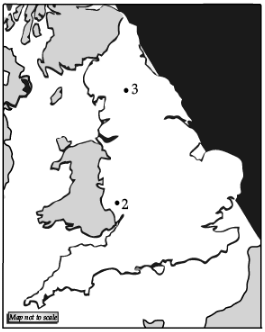
Ans: MAP
(i) (a) Leeds
(b) Sheffield
(ii) (a) Liverpool
(b) Bristol
(c) Bradford
